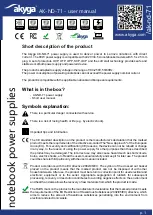
3
Use recommended accessories.
Consult the owner
’s manual for recommended accessories. The use of
improper accessories may cause risk of injury to persons.
Never stand on tool.
Serious injury could occur if the tool is tipped or if the cutting tool is unintentionally
contacted.
Check damaged parts.
Before further use of the tools, a guard or other part that is damaged should be
carefully checked to determine that it will operate properly and perform its intended function
– check for
alignment of moving parts, binding of moving parts, breakage of parts, mounting , and any other conditions
that may affect its operation. A guard or other part that is damaged should be properly repaired or replaced.
Direction of feed.
Feed work into a blade or cutter against the direction of rotation of the blade or cutter only.
Never leave tool running unattended. Turn power off.
Don
’t leave tool until it comes to a complete stop.
Do not
perform jointing operation on material shorter than 8 in , narrower than 3/4 in, or less than 1/4 in thick.
Do not
perform planing operation on material shorter than 8 in , narrower than 3/4 in, or wider than 6
” in or
thinner than 1/2 in.
Maintain
the proper relationships of infeed and outfeed table surfaces and cutter head knife path.
Support
the work piece adequately at all times during operation; mqintain control of the work at all times.
Do not back
the work toword the infeed table.
Do not attempt
to perform an abnormal or a little-used operation without study and the use of adequate hold-
down/push blocks, jigs, fixtures, stops and the like.
Hand
safety.
It
is
good
practice
to
move
the
hands
in
an
alternate
motion
from
back
to
front
as
the
work
continues
through
the
cut.
Never
pass
the
hands
directly
over
the
cutter
knife.
As
one
hand
approaches
the
knives
remove
it
from
the
stock
in
an
arc
motion
and
place
it
back
on
the
stock
in
a
position
beyond
the
cutterknife.
Three
inch
rule.
When
working
a
piece
of
wood
on
the
jointer,
follow
the
3
inch
radius
rule.
The
hands
must
never
be
closer
than
3
inches
to
the
cutter
head.
Health
hazards.
Some
dust
created
by
power
sanding,
sawing,
grinding,
drilling
and
other
construction
activities
contains
chemicals
known
to
cause
cancer,
birth
defects
or
other
reproductive
harm.
Some
examples
of
these
chemicals
are:
*
Lead
from
lead-based
paint.
*
Crystalline
silica
from
bricks
and
cement
and
other
masonry
products.
*
Arsenic
and
chromium
from
chemically-treated
lumber.
Your
risk
from
these
exposures
varies,
depending
on
how
often
you
do
this
type
of
work.
To
reduce
your
exposure
to
these
chemicals,
work
in
a
well-ventilated
area,
and
work
with
approved
safety
equipment,
such
as
those
dust
masks
that
are
specifically
designed
to
filter
out
microscopic
particles.
Familiarize
yourself
with
the
following
safety
notices
used
in
this
manual:
CAUTION:
(This
means
that
if
precautions
are
not
heeded,
it
may
result
in
minor
or
moderate
injury
and/or
possible
machine
damage)
WARNING:
(This
means
that
if
precautions
are
not
heeded,
it
could
result
in
serious
injury
or
!
possibly
even
death).
!
!
Summary of Contents for 0006
Page 19: ...18 Wiring Diagrams...
Page 20: ...19 Parts Diagrams...
Page 21: ...20...
Page 22: ...21...





































